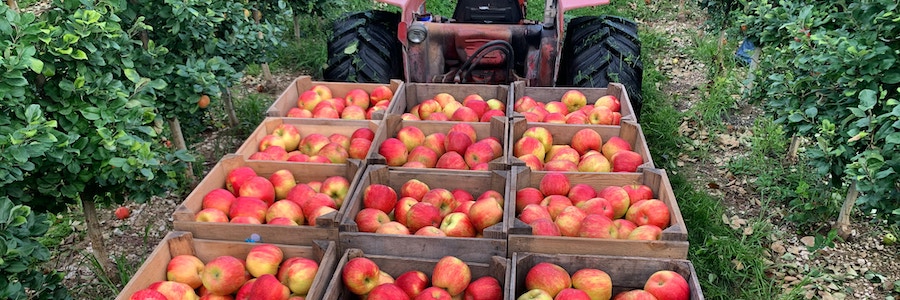Pumpkins, apples, oranges, wine grapes, broccoli, cabbage, carrots and (much, much) more. It’s fall harvest season in California, which produces most of the fresh produce and nearly all the tree nuts Americans eat. We raise livestock and are big in fiber (particularly cotton) too.
Today, because of the scientific wonder called California agriculture, many of these crops are actually produced throughout the year, even though we traditionally think of them as fall crops.
Fall also marks the two biggest annual food-focused holidays, Thanksgiving and Christmas. Much of what will grace American family dinner tables on these holidays is California-grown, raised and produced.
I include raised and produced as well as grown because California is one of the top turkey-producing states in the U.S. The state’s top turkey producers include Foster Farms and Zacky Farms, both located in the Central Valley. There also are numerous smaller producers, including many offering organic and premium birds, which have become popular choices for Thanksgiving even though their cost is considerably higher than conventional turkeys.
California also is the nation’s leading wine production state. Most Americans who indulge will be drinking California wine with their turkey and trimmings For Thanksgiving and enjoying it again for their Christmas and New Year celebrations.
I enjoy visiting California farms and harvest festivals in the fall so I can enjoy and marvel at the bounty of produce our state’s farmers produce. I also enjoy visiting farm stands and farmers markets, where California’s fall bounty is on full display, and where you can interact one-on-one with the farmers who grow what’s displayed.
Speaking of the Golden State’s bounty, California’s total land area covers about 104,765 acres. In contrast, a small percentage of that land mass, 28 million acres, are used to commercially grow food. California feeds the world utilizing these 28 million acres, which is a very small overall percentage of the state’s land mass.
The burning question in the California farm and agriculture community this fall harvest season is … ‘How much rain will we get?’ Will 2023 be a repeat of the deluge of 2022? Or, in contrast, will we return to drought-level rainfall?
Climate scientists and weather forecasters say they suspect this fall and winter will be as wet or wetter than last year’s torrential downpours.
Key to this suspicion by climate and weather experts is the fact the climate pattern known as El Niño has returned after a four-year hiatus, potentially ushering in the possibility of another stormy and wet fall and winter.

California farmers have been benefiting from all the water stored from last year’s storms and the snowpack that was created. Ironically though, another stormy year like last year might result in too much water because storage is at a minimum compared to 2021-2022. Let it rain. But not quite as not as it did much as last year.
Fall and November also are a good time to look at the new year to come. California agriculture faces numerous challenges in 2024 but one of the big ones, a shortage of water, is further down on the list than it has been for many years, thanks to a wet 2022. An equally wet winter in 2023 will push is a bit further down on the 2024 concerns list.
This year California also dodged the catastrophic wildfires of the recent past, which is something to be thankful for this Thanksgiving.
The labor shortage, which I’ve written about extensively in past columns, remains a major challenge for farmers going into 2024. Technology is addressing it in part but it’s only part of the solution because human labor remains vital in farming and other areas of agribusiness.
Climate change and carbon capture top the list right now in terms of the major issues and challenges California farmers and agriculture face.
For example, here’s what the California Climate & Agriculture Network (CalCan) said in a recent white paper on climate change: “California agriculture is uniquely vulnerable to climate change. Rising temperatures, constrained water resources, and increased pest and disease pressure are among the climate change impacts that threaten to fundamentally challenge California agriculture in the coming years and decades. Significant investments in research, technical assistance and financial incentives will be needed to keep California agriculture viable and assist the industry in adapting to climate change.”
Climate change is a top priority of the Biden administration and its USDA, which is making unprecedented amounts of money available to farmers and others to address climate change and carbon capture. There’s cause for optimism based on positive movements made by both government and industry this year.
California farmers too are resilient and innovative and are the original conservationists. My bet is they’ll continue to survive and many will thrive despite climate change and the other major challenges to farming we face here in the Golden State. This fall is evidence of this. If you don’t believe me, get out there and see it for yourself, and marvel at the abundance of California produce and more our farmers have produced this fall harvest season, as well as throughout the year.
My Job Depends on Ag Magazine columnist and contributing editor Victor Martino is an agrifood industry consultant, entrepreneur and writer. One of his passions and current projects is working with farmers who want to develop their own branded food products. You can contact him at: victormartino415@gmail.com.







